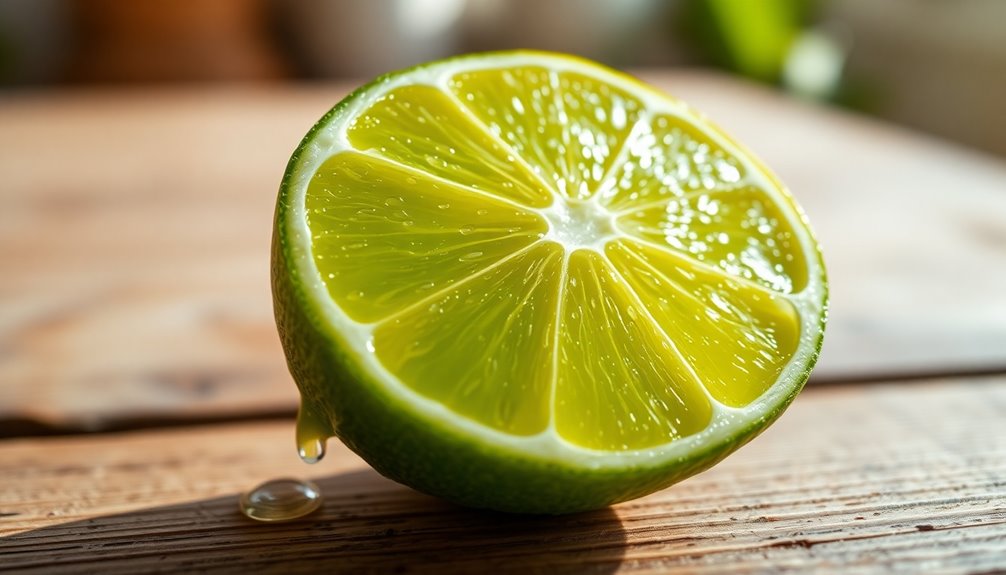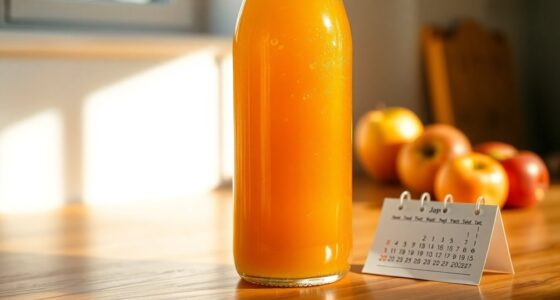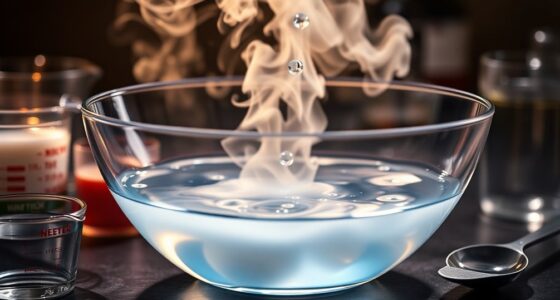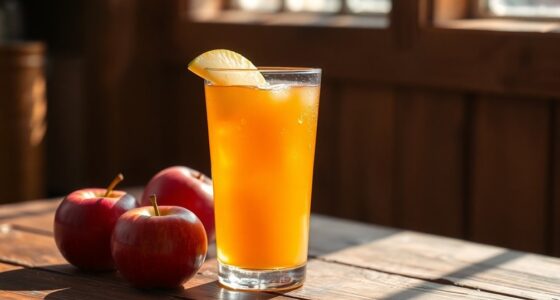Half a lime usually gives you about 1 tablespoon of juice, which is perfect for boosting flavors in your recipes or cocktails. This amount adds a refreshing zing without overwhelming the dish. For more juice extraction, try rolling the lime on the countertop first; it helps break down the membranes. Fresh lime juice can really brighten your meals and drinks, and there's plenty more to discover about its uses and benefits!
Key Takeaways
- Half a lime typically yields about 1 tablespoon (0.5 ounces) of juice.
- A whole lime generally produces around 2 tablespoons of juice.
- Fresh lime juice is preferred for its brighter flavor compared to bottled juice.
- Rolling the lime on a countertop before juicing can maximize the juice yield.
- Just a tablespoon of lime juice can significantly enhance the flavor of various dishes.
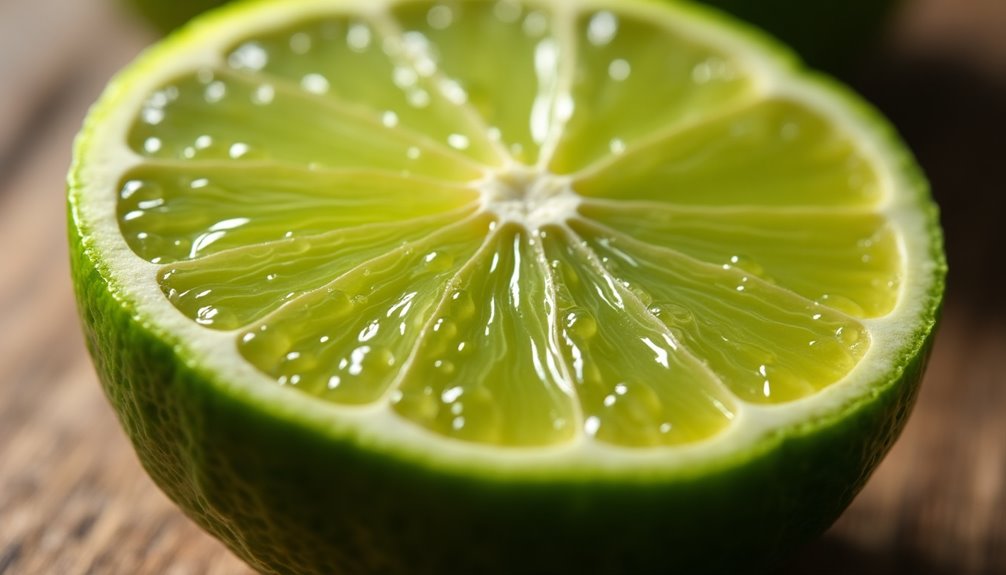
Have you ever wondered how much juice you can squeeze from half a lime? If you're cooking or mixing cocktails, knowing the amount of juice you'll get from half a lime can be pretty handy. On average, you can expect about 1 tablespoon of juice, which is roughly 0.5 ounces. This amount is perfect for adding a zesty touch to your dishes without overpowering the other flavors.
When you're juicing limes, remember that one whole lime typically yields about 2 tablespoons of juice. So, if you're only using half, you're still getting a reasonable portion for most culinary applications. This makes half a lime a great choice for recipes that call for a subtle enhancement rather than a dominant lime flavor. It's especially useful in dressings, marinades, and cocktails where you want just a hint of that zesty freshness.
You'll find that fresh lime juice has a brighter flavor compared to bottled lime juice. This is why many chefs and home cooks prefer using freshly squeezed juice, even if it's just from half a lime. The difference in taste can elevate your dishes and drinks significantly. Just think about your favorite margarita or a tangy vinaigrette; the fresh lime juice really brings those recipes to life.
To maximize the amount of juice you get from half a lime, try rolling the lime on the countertop before cutting it open. This technique helps break down the membranes inside, allowing for easier juicing and more juice extraction. You'll be surprised at how much more you can get out of that half lime with just a little effort.
Whether you're using it in cocktails, cooking, or even baking, fresh lime juice can add that perfect touch of acidity. Just a tablespoon of juice can enhance the overall flavor profile of your dish, making it more vibrant and enjoyable. So, the next time you're in the kitchen, don't underestimate the power of half a lime.
Frequently Asked Questions
How Much Juice Is in 1/2 Lime?
When you're juicing a lime, you'll typically find that half a medium lime gives you about 1 tablespoon of juice, or 1/2 ounce.
The exact amount can vary based on the lime's size and ripeness, so rolling it on the counter before cutting can help you get the most out of it.
This fresh juice can really brighten up your dishes and drinks, adding a zesty flavor that's hard to beat!
Can I Substitute Bottled Lime Juice for Fresh Lime Juice?
Certainly, you can substitute bottled lime juice for fresh lime juice when necessary.
However, keep in mind that bottled juice often lacks the lively lift and luscious flavor of its fresh counterpart. If you're aiming for authentic taste, fresh is best.
For specific recipes, one tablespoon of bottled juice can replace the juice from half a lime, but don't expect the same vibrant zing.
Always choose organic bottled juice for a better balance.
How Many Ounces Is Half a Lime?
When you cut a medium lime in half, you can expect to get about 1 ounce of juice from it. This is roughly equivalent to 2 tablespoons.
However, keep in mind that the actual amount might vary based on the lime's size and ripeness. If you're using it for a recipe, half a lime usually provides plenty of flavor, especially when you choose a bright green, smooth-skinned lime for juicing.
How Much Is Juice From One Lime?
Isn't it interesting how a simple lime can brighten up your dish?
When you squeeze one medium lime, you typically get about 2 tablespoons of fresh juice, which is around 1 ounce. This amount can vary slightly depending on the juiciness of the lime, but for most recipes, this measurement is a reliable guideline. If you’re preparing a dish that requires more juice, it’s helpful to know how much juice from limes you can expect; using two medium limes will generally yield around 4 tablespoons, or 2 ounces of juice. Always remember to roll the lime on a hard surface before cutting it open to release even more juice. To maximize the juice extraction, consider using a citrus juicer or reamer, which can help you get every last drop. If you’re unsure about how much juice from two limes you’ll need for your recipe, it’s always a good idea to have an extra lime on hand, just in case. Fresh lime juice can elevate your dish’s flavor, so achieving the right amount is essential for the perfect balance.
Keep in mind that the actual amount might vary slightly based on the lime's size and ripeness.
To get the most juice, roll the lime on a countertop before slicing it.
You'll really appreciate that vibrant flavor in your recipes!
Conclusion
In the grand orchard of life, a half lime is like a fleeting moment, bursting with zest yet humble in its offering. Just as you savor its tangy essence, remember that even the smallest slice can brighten your day. So, as you squeeze out those precious drops, think of the joy they bring. Embrace the little things, for it's often in the tiniest treasures that we find the most vibrant flavors of our journey.
Cindy thoroughly researches juicing trends, techniques, and recipes to provide readers with practical advice and inspiration. Her writing style is accessible, engaging, and designed to make complex concepts easy to understand. Cindy’s dedication to promoting the advantages of juicing shines through her work, empowering readers to make positive changes in their lives through the simple act of juicing.

